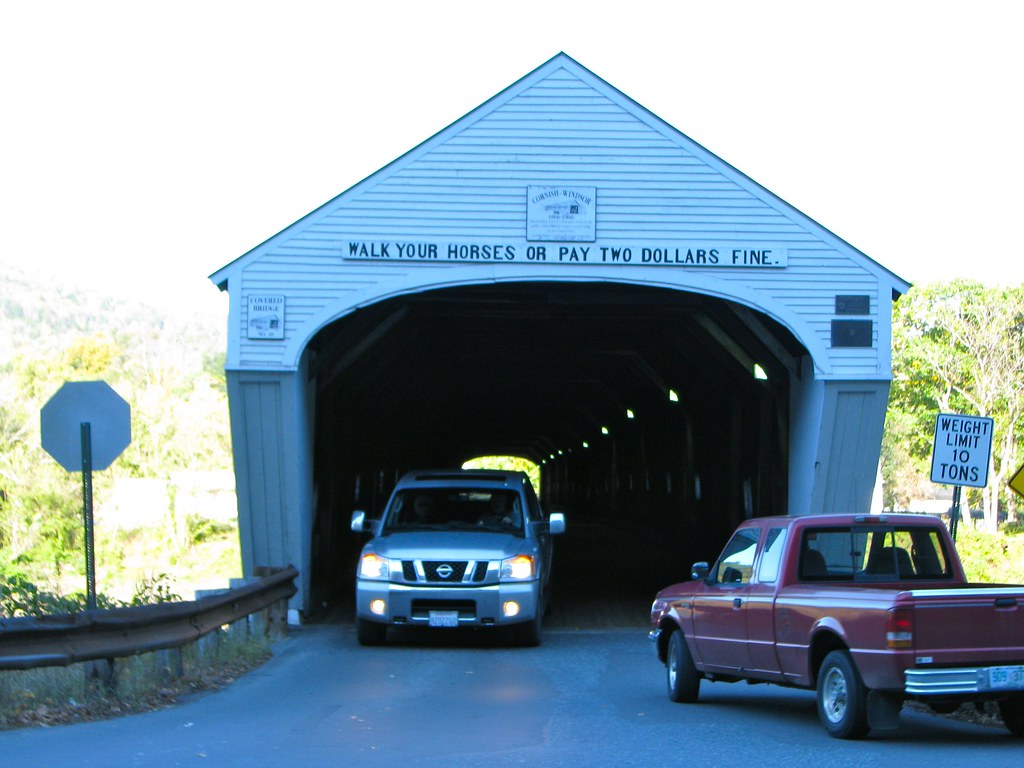Between Cornish, New Hampshire and Windsor, Vermont (October 2010)
We happened to be in Windsor, Vermont for a long autumn weekend as the leaves began to change color, and decided to visit the historic home of August Saint-Gaudens in nearby Cornish. The most efficient way to do that is by taking the wonderful Cornish-Windsor covered bridge (map).
Crossing the Connecticut River

It’s a remarkable bridge and the drive from Vermont into New Hampshire went smoothly. Windsor is a town of about 3,500 people with most of its inhabitants living within close proximity to the foot of the bridge. Cornish has only about 1,500 people with a population spread throughout a much larger rural area.
The population concentration on the Vermont side of the border made this a convenient location for a bridge, yet Windsor gets second-billing on the name of the bridge. That’s because the Connecticut River, which forms the boundary between the two states, belongs to New Hampshire as does the bridge: it’s their bridge so it’s their name. Some debate whether “Windsor” should even be included on the name of the bridge at all, but it’s safe to say that at least a tiny part of the bridge extends into Vermont or cars wouldn’t be able to use it.
History

I could go into a lot of detail about the history and design of the bridge but that would be redundant. The state of New Hampshire already provides that at a marker posted at a small pullout immediately south of where the bridge crosses onto dry land in their state. Here is the marker and a transcription in case it’s difficult to read on the photograph:
CORNISH – WINDSOR BRIDGE
Build in 1866 at a cost of $9,000, this is the
longest wooden bridge in the United States and
the longest two-span covered bridge in the world.
The fourth bridge at this site, the 460-foot
structure was built by Bela J. Fletcher (1811-1877)
of Claremont and James F. Tasker (1826-1903)
of Cornish, using a lattice truss patented by
architect Ithiel Town in 1820 and 1835. Built as
a toll bridge by a private corporation, the span
was purchased by the state of New Hampshire in
1936 and made toll-free in 1943.
Long But Not Longest

It should be noted that some of the information about the Cornish-Windsor bridge found on the Internet is out-of-date. I find that people often don’t conduct any original research or fact-finding when posting details, they just copy and paste text directly from other sources. You’ll see many references to this bridge as being the “longest covered bridge in the United States.” or the the “longest wooden covered bridge in the United States.” Neither is true anymore.
The 1866 structure stretches to an impressive length but it was eclipsed by the 613 foot Smolen-Gulf Bridge in Ashtabula County, Ohio in October 2008. The Cornish-Windsor Bridge still has the longest single span that carries automobile traffic (204 feet) but that’s seems like a bit of a consolation prize. However, don’t visit the bridge for its superlatives, just go there and enjoy it for it’s scenic beauty.
Walk Your Horses

The Cornish–Windsor Covered Bridge is a quaint attraction in an historic setting, a throwback to an earlier time. I like the way that New Hampshire continues to include whimsical signage above the span: “Walk your horses or pay two dollar fine.” I can’t imagine there are too many horses crossing the bridge today, much less people being levied with two dollar fines for noncompliance. However, it’s nice to think back to the way things used to be a century ago.

Leave a Reply